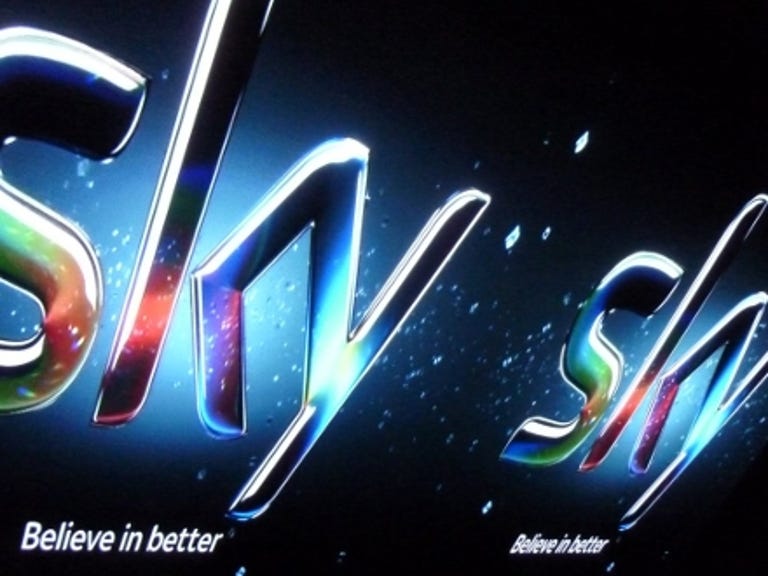 Why You Can Trust CNET
Why You Can Trust CNET Sky 3D review: Sky 3D
Bin your preconceptions -- Sky 3D really does usher in a whole new way of enjoying TV. Consumed in small doses, Sky's 3D channel is fun, fresh and frighteningly addictive.
Legendary US film critic Roger Ebert is not a fan of 3D. He recently described it as "a waste of a perfectly good dimension". Francis Ford Coppola, director of The Godfather, is of similar mind, branding it "tiresome". But the good folks at Sky take a different view, hoping to turn us into a nation of goggle-wearing geeks with the launch of the first 3D channel on their service.
The Good
The Bad
The Bottom Line
The launch, on 1 October, has taken on a huge significance, not least for manufacturers of 3D TVs, since they're all desperate for the technology to catch on. So will Sky 3D reinvent TV or is it just a gimmick? We've watched it and this is our verdict.
3D icing on the cake
The good news is that Sky's 3D service works with both passive-polarisation 3D TVs (from, erm, LG) and active-shutter sets (from everybody else... and LG). You don't even need any new Sky hardware to watch it. Any Sky+HD box will work. Just connect the satellite receiver to your 3D TV with an HDMI lead, enable channel 217 with a quick call to Sky's service centre, and you'll be away. There isn't even an additional charge, provided you already subscribe to one of Sky's top-tier packages. Sky 3D is just an extra dollop of icing on the cake.
It doesn't take long to realise that Sky 3D isn't actually hi-def. Although it uses the HD platform, the image resolution is effectively half that of a 1080p channel. This is because Sky uses a 'side-by-side' broadcasting format. Imagine a single HD frame carrying two near-identical images -- one for the left eye and one for the right. As far as the HD set-top box is concerned, this mess is just another 1080i picture. But, when you engage the 3D mode on your new telly, these two images are geometrically adjusted on top of each other, allowing your 3D glasses to display them as a full-frame 3D image.
No auto-switching
Over the past few weeks, we've auditioned Sky 3D on a variety of TVs, including Panasonic's Viera TX-P46VT20 plasma set. When fed the signal from our Sky+HD 1TB box, the Panasonic TV didn't recognise it as a 3D signal. Consequently, we had to manually select the correct viewing mode.

This problem is probably due to the fact that no Sky box is equipped with an HDMI 1.4 output. It's this iteration of the HDMI spec that carries all the control codes that lock the 3D source to the screen. Had the signal come from a 3D Blu-ray player, the Panasonic telly would have known what to do with it.
Frogs look better than footie
Given Sky 3D's resolution, we feared that images might look overly soft. But this isn't the case. The picture clarity is akin to that of a decent DVD. This is most evident in the case of Sky's 3D football footage. Although the beautiful game itself doesn't really benefit at all from the stereoscopic process, crowd scenes gain genuine depth -- it really is like looking through a window. The detail is good enough so that you can pick out faces in the crowd.
Sky is taking a different 3D approach to different sports, so results tend to vary. That said, its use of 3D graphics and overlays is consistently great fun. While we were largely underwhelmed with the football, the channel's boxing test footage proved astoundingly involving.
3D is a perfect fit for nature fans. Frogs, lizards, butterflies and sundry amphibians all perform well in front of the 3D camera, with tongues and eyes bulging out of the frame on cue. Experimental footage of the City of London, sped up, proved equally mesmerising. While watching 3D content, we experienced an almost irresistible urge to move closer to the screen (far more so than with 2D footage). Even with our nose up to the glass, we just didn't feel that close as the 3D image receded.
Sky's film show, 35mm, has the potential to be a great showcase for the technology. We loved its special 3D preview episode, shot entirely with eye-popping cameras and featuring 3D trailers of upcoming features and past hits. James Cameron's Avatar may have looked slightly soft, but CGI clips of Despicable Me and How to Train Your Dragon were spectacular.
Beware, though, that, when in 3D mode, Sky's electronic programme guide remains 2D. Hit the pause button and it's like taking a spear in the back of your retina. The next logical step would be some kind of 3D EPG, but don't expect such a thing anytime soon.
Passive 3D vs active 3D
We auditioned the service on both passive and active 3D TVs. Given that passive screens shave the resolution off all incoming 3D signals (which is why they're far from ideal for playing back 3D Blu-rays), we had low expectations for their performance with Sky. Our expectations were confounded, though -- the viewing experience was fine.
You can expect to experience some differences in 3D picture quality with different manufacturers' TVs, if only because of the different picture-processing technologies deployed. Philips, for example, is planning to use proprietary picture-upscaling technology to beef up the half-resolution transmissions. We predict this is one area in which TV vendors will begin to crow during the coming months.
Conclusion
Sky 3D has a definite wow factor. There's no doubt that a mainstream audience, with scant interest in the technology behind the glasses, will quickly warm to it. Whether it has legs very much depends on what kind of material Sky is able to put out. Not that we want to see everything in 3D -- far from it -- just the occasional sports match, some concerts perhaps, and, inevitably, porn Avatar.
Edited by Charles Kloet
